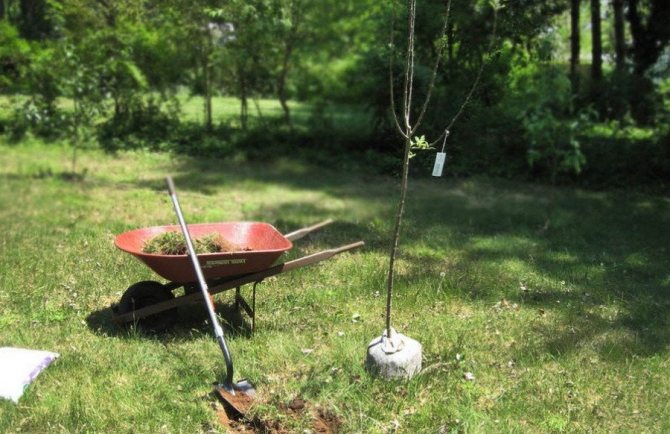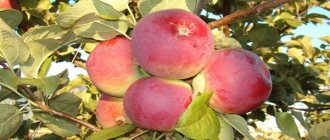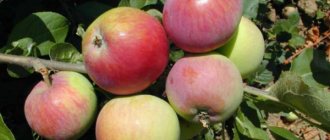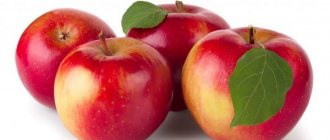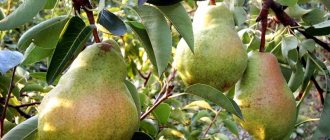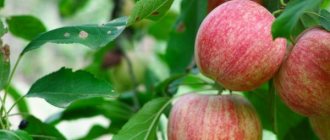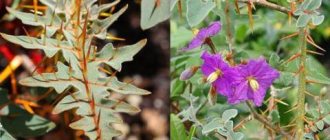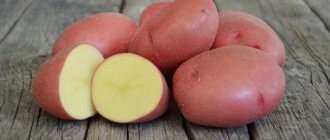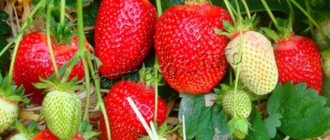This name has long been known to gardeners and often awakens fond memories of tasty, fruitful and famous apple variety... Now it is somewhat supplanted by overseas novelties, but this does not detract from its qualities and merits.
This variety combines many wonderful qualities, undeniable advantages. The fruits have excellent taste, good yield and frost resistance. The variety is reliable, time-tested.
This explains such a great sympathy and love of gardeners for him.
Description
This variety was bred in 1928 at the M. Semirenko L.P. in Ukraine. Another name - Glory to the survivors.
The varieties were crossed Papier and Macintosh. And since 1954, it has been zoned throughout the former Union.
This is very popular variety of autumn ripening:
- Its fruiting is stable,
- High yield,
- Good winter hardiness,
- Disease resistance: powdery mildew and scab - medium.
This apple tree belongs to tall, crown pyramidal.
The bark of the main branches brown.
Leaves are light green, rounded.
Flowers pink, saucer-shaped, red buds.
Fruit with smooth skin of medium to large size. The color of ripe fruits is light green with a red blush. The pulp of the fruit is light, slightly creamy. The apples are juicy, fragrant, sweet and sour taste.
Important! Depending on the region, fruits ripen from early August to early September.
Characteristics, description of the variety with photo
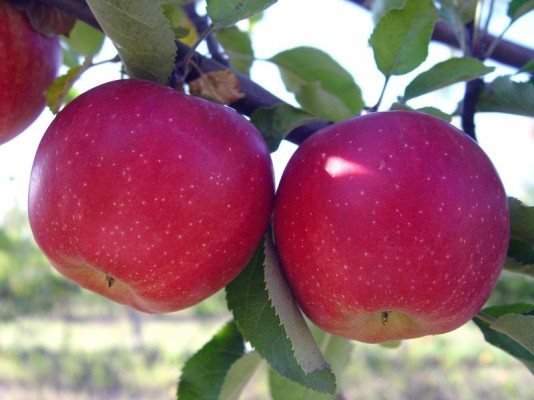
The apple tree is summer-autumn. The timing of the harvest depends on the region. In the south, fruits are harvested in the first decade of August. In regions with a cool climate, apples ripen by the end of August or early September.
The apple tree is self-fertile and for fruiting it requires a neighborhood with a pollinator tree, for example, Borovinka, Melba, Antonovka, Vadimovka, Priam, Delcia.
In warm regions, the first harvest from a tree can be obtained in 4 years. In regions with a cold climate, fruiting begins 5-6 years after grafting or planting.
The yield of a tree at the age of 8 is 75 kilograms, from 10 years it reaches 100 kilograms. The trees produce an annual and stable harvest.
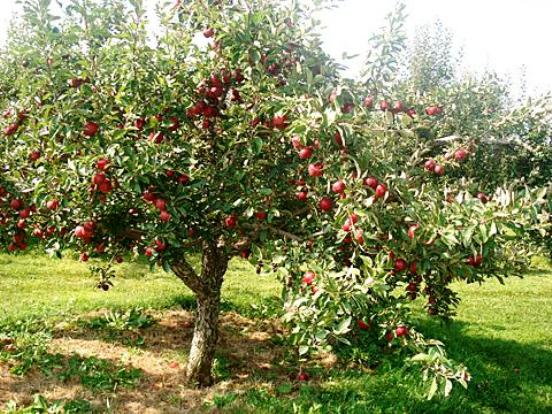

The apple tree is vigorous, about 3.8 meters in height. A young tree has a wide-pyramidal crown. In an adult tree, it is large, highly oval or highly round, spreading and dense. The bark is brown. Skeletal branches of a young apple tree in relation to the stem grow at an acute angle, with age they grow to the sides. Shoots are brown, straight. The apple tree is prone to strong shoots. Lentils are small, there are many of them. The stems of the sapling are shiny, slightly elbowed, reddish-brown in color.
Leaves are light green, slightly yellowish, smooth, curved, of medium size, round or oval, slightly pubescent. The tip of the leaf is shortly pointed. At the base, the leaf is slightly curved along the midrib. The petioles are not bright. Stipules are lanceolate and small.
Red buds. The flowers are pink, saucer-shaped, fragrant. The filaments of the flower are colored red at the base.
Fruiting is mixed, fruits are formed on ringlets and twigs.


The fruits are quite large, weighing 130-200 grams. The shape is oblong-rounded, even or slightly ribbed. The upper part of the fruit is round or slightly conical in shape. The peduncle is long, not too thick. The apple skin is thin, smooth, with a light silvery waxy coating. At the beginning of ripening, it is greenish; when fully ripe, it becomes covered with a thick red blush. There are many light subcutaneous points. The pulp is whitish-creamy, juicy, sour-sweet, soft and tender. The aroma is pronounced, bright.
When fully ripe, the fruits begin to fall off intensively. The apples should be picked a week before they are fully ripe. In a cold place, apples are stored for up to 3.5 months. They are also suitable for fresh consumption and processing.
Tasting taste assessment on a five-point scale - 4.5 points.
Apples per 100 grams of product contain:
Sugar - up to 14.4%; titratable acids - 0.8-1% R-active substances - 112 milligrams; ascorbic acid - up to 10 milligrams.
Also in fruits there is a large amount of iodine, phosphorus, iron, calcium, vitamins of group B, E, pectin, carotene, easily digestible acids.
Additional characteristic
origin of name
Apples of the Slava Winners variety ripen, when the earlier apples have already completed fruiting, and the autumn ones are still poured. During this period, juicy beauties appear in all their glory, enter the arena as winners... And Glory to the Winners!
Features of the
- Wood looks very impressive during flowering, blooms profusely.
- Flowers emit a delicate aroma.
- Apples very juicy when ripe.
- This apple tree belongs to the category of reliable varieties, it brings stable and rich yields.
Interesting! A distinctive feature of the variety is that when ripe, the seeds do not grow together with the seed chamber, remain free and thunder when shaken.
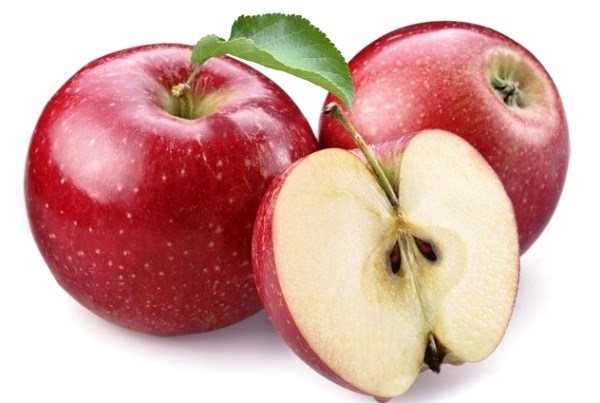

Apples Glory to the Winner.
Winter hardiness
Apple variety Winner has good winter hardiness.
For this reason, they can be grown both in the more northern regions and in the southern ones. In this case, the ripening time of the fruits will also change accordingly.
Tree height, crown width
Apple tree Glory is a vigorous tree.
Crown it - wide pyramidal. Over the years, the shape of the crown changes. Becomes highly rounded or highly oval.
Branches are at sharp angles to the trunk, going up. But then the location of the branches changes, they grow to the sides.
Bark color
Main branches apple trees have a brown bark, shoots are straight in shape.
Young shoots have a reddish-brown color, they are shiny, slightly geniculate.
Leaves are of medium size, rounded, pointed at the ends, light green in color.
They have a slightly noticeable yellowness, weak pubescence, weakly colored petioles and small stipules.
Breeding features
Apple-tree Glory to the Winners is self-fruitless. Such apple trees unable to self-pollinate... These are many varieties of apple trees.
The yield of these fruit trees depends on the pollination of the pistil flowers of one variety with the pollen of another variety.
For such pollination it is desirable that suitable trees grew at a distance of no more than fifty meters... For example, it can be apple trees from a neighboring suburban area.
These features of the variety must be considered when planting an apple orchard... Apple trees are selected in such a way that they have the same time of entry into the fruiting season.
The beginning of fruiting
The timing of the onset of fruiting depends on the area of growth.... They are considered to be of medium fertility.
Farther south these trees begin to bear fruit 4-5 years after planting.
In the extreme south these terms can be reduced to two years.
But in the northern regions fruiting occurs much later.
First years apple trees give a good harvest every year, but then - with a certain frequency.
Their fertility is above average.... The number of apples harvested from one hectare of the orchard area is 110-200 centners.
Important! With good yield and frost resistance, the Slava Winners variety has a low drought resistance.
Scab resistance
To this fungal disease in the apple tree medium resistance:
- Leavesthose affected by this disease become covered with dark spots, curl, dry out, then fall off.
- Fruit can also become stained and deformed.
It is necessary to monitor the condition of the leaves and fruits of the tree, promptly carry out treatment with chemicals that prevent the onset of this disease.
Tasting assessment
Apples Glory to the Winners have great taste.
The pulp is tender, juicy, fragrant. Its color is white-yellowish or light cream, sweet and sour taste... On the tasting scale (five-point system), they are equal to 4.4-4.6 points.
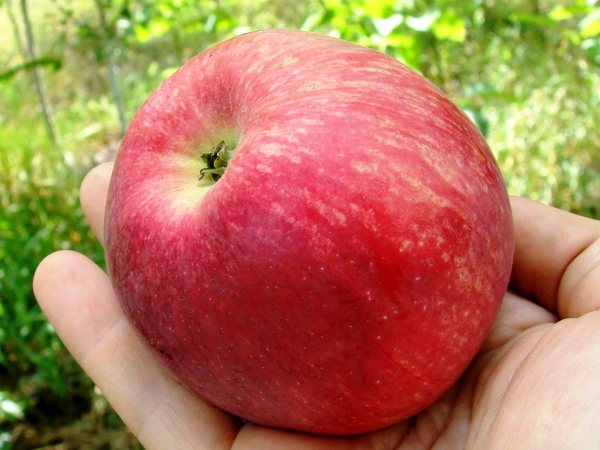

Apple fruit Glory to the Winners.
The composition of the fruit includes sugars, vitamins - C, B, E, P-active substances, minerals.
Advice! The fruits of the apple tree are consumed fresh. They make excellent jams, preserves, delicious juices, use them for drying, wet.
Advantages and disadvantages of the variety
The positive qualities of a tree include:
- good care guarantees a high yield;
- perfectly tolerates severe frosts, rarely freezes;
- stable yield, which means that the tree bears fruit annually;
- apples have good transportability and a high tasting rating, have a good appearance.
Negative qualities:
- The variety is hygrophilous. Drought-resistant. In hot areas, unripe apples, which are not yet edible, fall off prematurely.
- The thickened crown of the tree affects the quality of the apples. All the plant's strength goes into maintaining the branches. As a result, the fruits become small and lose their taste. Therefore, the crown of the tree is thinned out every season.
- Drought-resistant. To maintain a healthy look of the culture and preserve the taste and appearance of apples, you will have to water regularly.
- Requires pollinators. It is necessary to plant fruit trees nearby.
- Due to the tendency to fall off quickly, it is necessary to monitor the degree of maturity and remove the fruits from the tree in time.


With proper care, the plant will bring only positive emotions and delight you with a delicious harvest.
Testimonials
Irina: I got this apple tree at the age of two, having met a description, photo, reviews. AND the first crop we harvested in the third year after planting... The apples are wonderful and juicy. When the apple tree blossomed, the weather was not very warm, the bees did not fly much. And we, taking the flowers of apple trees from a neighboring site, tried to pollinate our apple tree by hand. Happened! But most of all I liked the fact that the pests did not touch our Slava, although the neighboring one suffered, many fruits were wormy.
Daria: In our family everyone loves fruits very much apple trees Glory to the Winners. Most are eaten fresh. I bake pies and strudels with apples.
Andrey Starkov: I do pruning in the garden and try to keep the branches of my apple and pear trees in order. The Glory to the Winner apple tree has to look after. Obligatory pruning and scab spraying. This apple tree is very good. The fruits are tasty, aromatic.
Olga Ivanovna: It is interesting to read about Slava's care for the Peremozhtsy. We have it growing for a long time, an old good variety, bought after the parents read the photo and description of the variety. Good fruiting, delicious apples. We love our beauty. Now we know that it is important not to allow thickening of the apple tree crown and spray from pests.
Landing
Apple trees are planted in autumn or spring, depending on the region and weather conditions:
- In a pre-prepared pit (diameter 70 cm, depth 1 m).
- The seedling is placed in a pit so as not to deepen the root collar too much.
- The roots are spread with your hands.
- Holding the trunk of the tree vertically, they cover it with prepared earth.
- The earth is carefully compacted.
- Then abundant watering is done (1 bucket).
- The tree is tied to a peg.
Care
Pollinating varieties
For the apple tree Slava Winners, the best varieties for pollination are:
- Melba,
- Vadimovka,
- Priam,
- James Grieve,
- Delicia,
- Antonovka is ordinary,
- Borovinka.
Pruning and shaping the crown
The crown of these apple trees characterized by strong branchingtherefore it is necessary to monitor its condition.
Avoid thickening, thin out.
It is necessary try to cut out non-fruiting branchessince such apple trees bear fruit on fruit twigs, ringlets, spears.
Important! It is advisable to preserve this part of the crown.
Top dressing
Top dressing starts in April - nitrogen-containing mixtures are introduced (only root feeding):
- Urea,
- Ammonium nitrate and nitrophoska,
- Humus.
Further - during flowering:
- Substances that activate vegetation: superphosphate,
- potassium sulfate,
- chicken droppings
- urea.
Next stage - feeding apple trees after flowering (phase of fruit filling): nitrophoska, green fertilizer.
In summer: in July - phosphorus and potash fertilizers. For the winter - feeding with phosphorus-potassium fertilizers.
Chemical treatment
The apple tree can be affected by such diseases:
- Powdery mildew,
- Scab,
- Cytosporosis,
- Fruit rot,
- Milky shine.
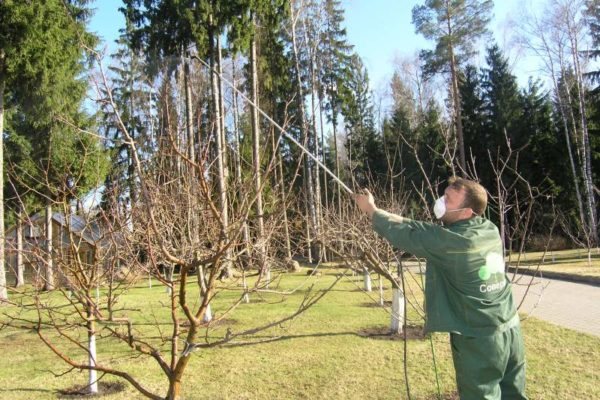

Spraying trees with copper sulfate.
To combat these diseases, drugs are used:
- Copper oxychloride,
- Topaz,
- Hom and other drugs.
Diseases and pests
The culture is affected by the most common pests of apple trees, which include:
- apple aphid;
- leaf roll;
- ticks;
- apple moth.
To avoid the spread of pests and diseases, it is necessary to carry out preventive measures in a timely manner.
Powdery mildew
A white bloom appears on the foliage, which can be easily removed by hand. Then it becomes brown in color. Subsequently, the leaves turn yellow and fall off prematurely. The tree becomes weak, stops growing and does not bear fruit.
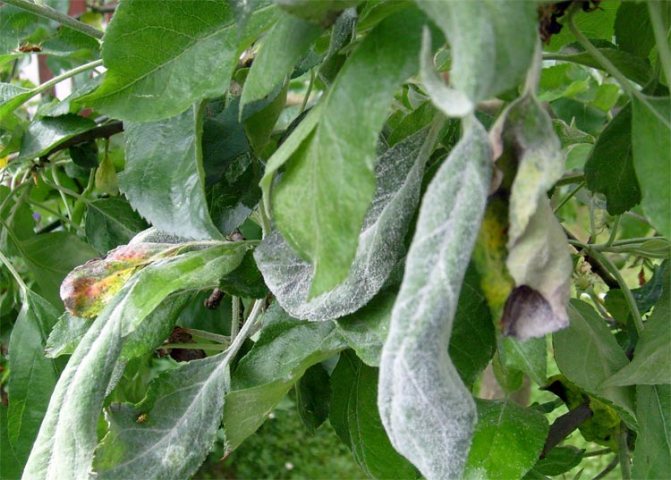

Scab
Refers to fungal diseases and affects the volume of the crop. The foliage curls and falls off. The fruits are covered with black spots.
Fruit rot
If the crop begins to rot profusely, then it is necessary to treat the culture with Topaz.
Milky shine
The foliage is affected first, then the disease moves to the branches and then to the wood. If you miss the moment and do not start fighting methods in time, the apple tree will die.
Features of ripening and fruiting
What year does it start to produce?
The beginning of fruiting of apple trees (on weak vegetative rootstocks) in the southern territories - 4-5 years, in the northern - later.
Fruiting type
In the first years, fruiting of the apple tree is regular, later - periodic. It depends on the condition of the soil.
Terms of ripening and storage of fruits
Ripening terms These apples range from the first half of August to the second half of September, depending on the region, from south to north, respectively.
Fruit preservation in the southern part (Kuban) is two weeks, in the Oryol region (middle lane) will be stored until December.
Yield
A young tree can yield up to 10-20 kg of apples from one tree. Growing up, the tree already gives about 70 kg, in the South - an average of 190-200 kg per hectare. The maximum yield is known - 300 kg per hectare.
Collection and storage of fruits
Chernenko's apples are picked in September. The shelf life of fruits is different, it depends on the weather in which they grew: whether there was precipitation or not, as well as temperature changes. If it rains, then such apples are stored for a shorter time. Watering of trees with fertilizer solutions is also taken into account. 90 days before the planned harvesting of fruits, nitrogen fertilization is stopped. They have a negative effect on shelf life.
To plant a Pobeda (Chernenko) apple tree in your garden or not, every gardener decides on his own, but if you are ready to put up with its shortcomings, then the advantages of this plant are especially capable of delighting. The Chernenko variety is a very good choice in those regions where it can be planted.
Varieties of rootstocks
The Slava Winner variety can be grafted onto dwarf, semi-dwarf and medium-sized rootstocks.
Rootstock for grafting apple trees are selected depending on:
- Areas where the apple tree will grow,
- Irrigation possibilities,
- From the type of plantings.
In addition to pome rootstocks, which are characterized by good frost and drought resistance, resistance to viral diseases, and clone, those. vegetative rootstocks:
- M9 - dwarf rootstock;
- MM106 - semi-dwarf rootstock and others.
They have good compatibility with the variety that is grafted onto them.
It is important that such a rootstock has a deterrent effect on the grafted variety, are characterized by good rooting (the root system formed by the stock is branched, fibrous).
The grafted tree begins to bear fruit earlier than on rootstocks grown from seeds.
So, in the southern regions on weak vegetative rootstocks, apple trees begin to bear fruit for 4-5 years, in more northern regions - later.
In addition, the productivity of the variety becomes much higher: up to 300 centners per hectare. This is due to denser plantings and improved soil conditions.
Attention! Using ordinary apple trees as rootstocks for columnar ones is impossible.
How to plant an apple tree correctly
Seedlings are chosen according to the following criteria:
- strong;
- healthy;
- height should be at least human height;
- branches should be evenly spaced;
- the root system is branched;
- vaccination - clean and dry.
If at least one condition is violated, then such a tree is not worth acquiring.
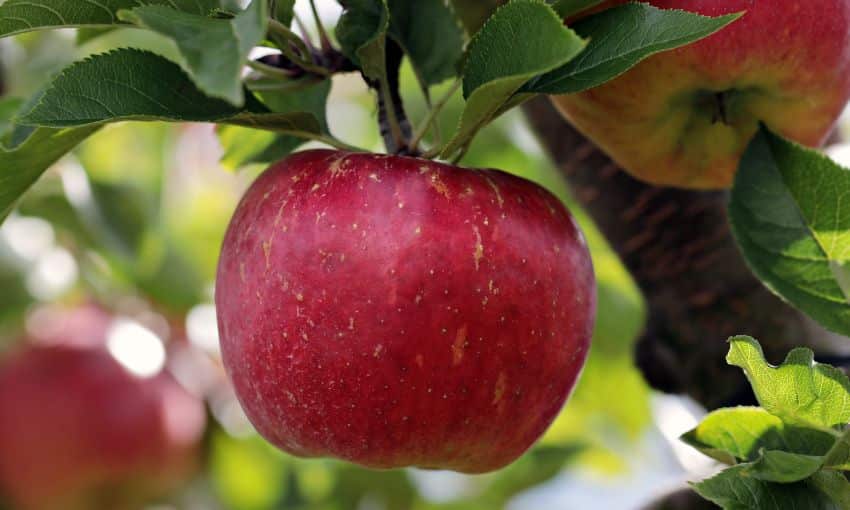

Choosing a place for a tree
They choose a place that is well lit with regular access to sunlight. Preference is given to areas protected from the wind, where rain and melt water does not stagnate.
See also
Description and characteristics of the Modi apple tree, yield, planting and careRead
Choosing soil for an apple tree
Ideal soil for a tree:
- loose;
- permeable;
- fertile.
It should always be moderately moist. When planting, the bottom layer is mixed in equal proportions with humus. Potassium salt and superphosphate are added. A cup of dolomite flour is added to the acidic soil.
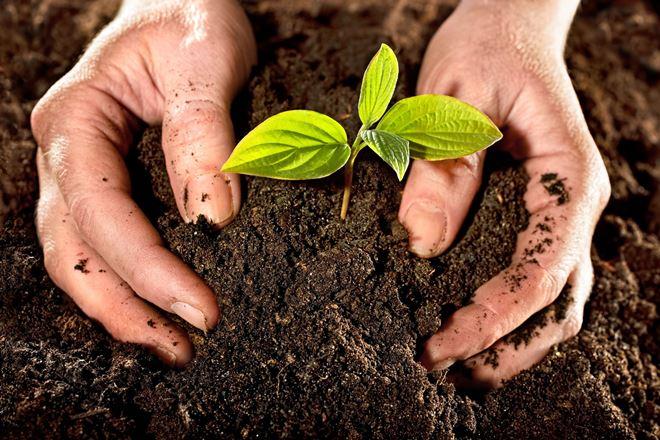

The procedure is carried out at least 3 weeks before planting the seedling, ideally 3 months. During this time, the soil mixture will naturally settle and form a homogeneous nutrient medium.
Sapling planting scheme
The hole is dug 80 centimeters deep. The diameter should be the same. The vaccination point cannot be buried. In the center of the hole, a stake is driven in, which will serve as a support for the tree. Before planting, the root system is straightened. After planting, the earth around is tamped and moistened with two buckets of water. Then mulch with straw or peat.
Features of cultivation in different regions
There is a direct relationship between the area where the apple tree grows and the ripening time of the crop. This period begins from the beginning of August in more southern areas and ends by the end of September much further north.
But apples grown in more southerly areas are stored less than apples from more northerly areas.


Growing apple trees.
So, the same the variety will behave differently in different climatic conditionsat.
Due to its frost resistance Glory to the Winners takes root well, practically in all regions of the former Soviet Union. Therefore, it is believed that in fact there is no zone where it grows in a natural way.
The Slava Pobeditel variety is suitable for cultivation both in the south and in northern areas, where it is cooler.
But the fertility of the apple tree changes depending on the area in which it is cultivated. And if in Ukraine this variety is late summer, in Central Russia it is already becoming autumn.
Attention! In the Moscow region, an apple tree can bear fruit once every two years. Autumn varieties yield there from September to November.


Apples on a tree branch.
The cultivation of these fruits in the Northwest is hampered, in addition to low temperatures in winter, by the composition of poor soils. The thickness of the fertile layer is small. Often these are peat bogs, loams, sands.
Apple trees grow well Glory to the Winner in:
- Ukraine,
- Belarus,
- North Caucasus.
Features of the apple tree Glory to the Winners
We told about the advantages of the Slava Winners variety over other apple varieties. Now let's talk about qualities that can be considered disadvantages. Timely collected fruits of the Glory apple tree for the Winners are normally amenable to transportation without prejudice to their presentation, but they can only be stored for up to one and a half months, even if optimal storage conditions are created. They last a little longer in the refrigerator. In addition, apples do not stick well to the tree, and may fall before they ripen. To prevent this from happening, apples must be removed immediately when the fruits reach technical maturity, that is, slightly unripe.
How to grow dwarf apple trees - planting and care
Despite these shortcomings, the popularity of the variety continues to grow. This is indicated by the reviews left on the forums by both amateurs and professionals. This apple variety is preferred by people who have appreciated the exceptional taste of its fruits, good yield and undemanding care.
This name has long been known to gardeners and often evokes fond memories of a delicious, fruitful and famous apple variety. Now it is somewhat supplanted by overseas novelties, but this does not detract from its qualities and merits.
This variety combines many wonderful qualities, undeniable advantages. The fruits have excellent taste, good yield and frost resistance. The variety is reliable, time-tested.
This explains such a great sympathy and love of gardeners for him.
Questions From Readers
Where can one buy?
In addition to garden nurseries, spring or autumn fruit markets, seedlings can be purchased through online stores.


Apple tree seedlings in the nursery.
What kind of processing is it suitable for?
Juicy, aromatic, tasty apples of this variety are well preserved. It is recommended to store them in cold cellars at 5-10 degrees. Celsius by placing in baskets or boxes.
Highly They are also good for making jam, jams, juices, compotes. It is also good to dry them.


